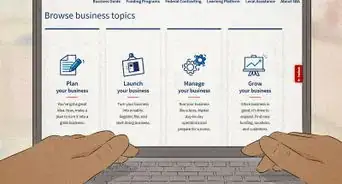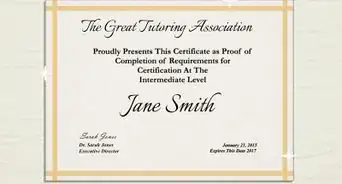This article was co-authored by Megan Morgan, PhD. Megan Morgan is a Graduate Program Academic Advisor in the School of Public & International Affairs at the University of Georgia. She earned her PhD in English from the University of Georgia in 2015.
There are 20 references cited in this article, which can be found at the bottom of the page.
This article has been viewed 50,757 times.
Do you have a talent or knowledge that you want to share with others? If you're a great tutor, you can actually help others from the comfort of your home and maybe earn some money from it. This article tells you how to use the internet to find an audience and impart knowledge online.
Steps
Making Initial Decisions
-
1
-
2Decide what you are qualified to tutor. You should only tutor in a subject or field in which you have plenty of experience and expertise. You should also be able to explain both very basic concepts and more advanced concepts in your area clearly.[7]
- If you are applying for an online tutoring job with another company, be aware that many of them have certain requirements, such as having a bachelor’s degree.
- You should be prepared to offer a list of qualifications to your prospective clients, even if you don’t have formal education credentials. For example, if you want to tutor people in how to run a successful blog, you should be able to provide your blog’s unique hits, your advertising revenue, your number of subscribers, etc.
- Do not attempt to become a tutor in a subject or field in which you don’t have appropriate credentials or relevant experience. Not only will you not do a good job, you could open yourself up to lawsuits for misrepresenting your services.
Advertisement -
3Decide on your rate. What you can reasonably charge will depend in large part on your qualifications. Obviously, someone with a college or graduate degree can command a higher fee than someone who lacks those credentials. Similarly, someone with an extremely popular blog with thousands of unique visitors a month could charge more for tutoring others on blog development than someone who doesn’t have the same professional experience.
- Private tutors usually charge anywhere from $15-$85 an hour.[8] [9]
- You may also prefer to charge a set fee per session or even per “package” of sessions (e.g., 4 a month).
- Whatever you choose, make sure that all your charges and fees are laid out clearly for your clients. Don’t surprise them with additional fees or charges later.
- If you will also need your clients to purchase additional supplies, such as workbooks, make sure that those costs are included in your fee or clearly communicated to the client.
Setting Up Shop
-
1Draw up a curriculum or a training plan for your tutoring. The simplest way to do this is with a word processing tool or a spreadsheet. Software programs that allow you to make mind maps and charts can also come in handy.
- You should be prepared to address common issues in the subject or area in which you want to tutor. For example, if you want to tutor English language, you should probably prepare several lessons about grammatical basics such as subject/verb agreement, pronoun/antecedent agreement, etc.
- There are many teacher-training resources online that could be helpful to you as you develop your curriculum. Harvard’s “Harvard Bridge Tutor Program” includes lesson plan templates and sample questions and answers. An online search for “tutor lesson plans” will produce many helpful resources.
- Your curriculum also needs to address outcomes, or how you know whether you have been successful or not. For example, will you use quizzes or tests? Self-report measures such as the student performing better in her/his classes? You must have a set of benchmarks so that you can gauge your students’ progress.
-
2Develop a script according to the curriculum. Make notes of important things that you want to say or demonstrate. You don't have to stick to a script throughout your lessons, but having some ideas down on paper and memorized will really help your flow and make sure you don't miss anything vital in your sessions.
- It’s important that you be familiar enough with your material that you can improvise and redirect your lessons according to the students’ individual needs. Remember that as a tutor you must go at the student’s pace, not the one you’ve pre-planned. Plan to be flexible.
-
3Gather all associated material that you may require. Because of the online format, you may need links, video or audio clips, articles, and photographs as instruction tools. Make sure you're familiar with them all before you begin your lessons; nothing slows an online tutoring session down like the tutor needing to figure out a software or website before they can show their students
- It can be helpful to create a “notebook” (such as a Google Doc or a OneNote binder) with all of the important links, videos, and online resources organized by subject or student. That way, you will have ready access to them during each session.
-
4Ensure that you have a reliable internet service and appropriate technology. Tutoring online requires a fast and reliable internet connection. You will also need a computer that is fast enough to handle memory-intensive applications such as video conferencing and virtual classrooms.[10]
- You will also need some sort of A/V equipment. The most basic is a headset with a microphone. You may also prefer to use a webcam so that your clients can see you.
-
5Choose a suitable online platform for delivery. The ideal solution may depend on what you want to teach. You can choose from a variety of free and paid audio and video conferencing tools. You can do basic lessons using simple platforms like Skype or Google Hangouts and Google Documents, or you can research more elaborate conferencing platforms to up the ante on the interactive portions of your presentations.[11]
- Consider an application that provides a virtual “whiteboard,” such as Idroo, Scribblar, or Talk and Write.
- Paid platforms that allow videoconferencing and even group conferences include Webex[12] , Gotomeeting[13] , and Wiziq[14] .
- Skype allows you to share your screen with other people, which can be very helpful if you are tutoring someone in how to use a computer or do technical tasks. Other places that allow you to share a screen include join.me and screenleap[15] .
-
6Set up a payment service. The most popular way of sending payment online is PayPal, which allows you to accept payment from people worldwide. They charge small fees per transaction, but for convenience and reliability it’s a great choice. You can send invoices to clients through their web portal.[16]
- PayPal also has a set of “merchant services” that will allow you to accept credit cards on a personal website or through a mobile device.
- It’s important to ensure that you are paid before your tutoring session. It can be very difficult to track down deadbeat customers if they fail to pay after you’ve completed your session.
-
7Run some practice sessions. Before you go “live” with real students, it’s a good idea to practice your tutoring skills with some obliging friends. If you can, choose friends who are not very familiar with the subject(s) you want to teach. This way, you’ll know if you are adequately explaining your topics.
- Run these sessions just as you would live online sessions with paying clients. Use the same software, spend the same amount of time preparing and teaching, and answer questions the same way you plan to when you start offering your services.
- Ask for honest feedback. Encourage your friends to let you know what didn’t work well, or any area where they think you could clarify or perform better. Don’t take criticism personally; this advice will help you ensure that you offer the best possible product to your clients.
Attracting and Working With Clients
-
1Provide your contact information. You may want to create fliers or business cards that include your contact info to leave around your neighborhood. Good choices include coffee shops, libraries, and bookstores.
- Make sure you ask permission before posting fliers or leaving business cards.
- Provide alternate methods of communicating, such as an email address and a phone number.
- Make sure you thoroughly proofread your materials before posting them. Nobody will want to hire a tutor whose ads contain typos.
-
2Create a database of potential learners. You can start by finding tutors within your personal network and through recommendations, and then expand to building a following online.
- One way to build a network of recommenders could be to offer a “free” lesson to interested parties, such as teachers or parents. That way they can see what clients are getting, and will be more comfortable recommending your services.
-
3Run an ad on craigslist. Craigslist is a huge online platform that reaches lots of people in your area. Ads are usually free. Post a listing that clearly describes your services, availability, contact information, and rates.
- Craigslist has a “lessons & tutoring” section of their website under the “Services” category. Post your ad in this section for the best exposure.[17]
-
4Sign up on freelancing platforms. There are several websites where you can sign up as a freelancer available for hire. Create a profile, explain your skills, and market your services.[18]
-
5Prepare to answer questions. Most potential clients will want to interview you before hiring you. They may do this over email, phone, or request an in-person meeting if they live in your area. You should be prepared to answer the following types of questions:[21]
- What kind of training or credentials do you have in your subject or area?
- Have you tutored before?
- Are you experienced with different learning styles?
- How would you help me with _____ issue?
- What is your availability?
- How much do you charge? Do you offer discounts?
- Do you have any references?
-
6Create a tutoring schedule. For each student you work with, you'll want to set up regular appointments at times that work for both of you. Make sure you can stick to your schedule; just because you're providing online tutoring doesn't mean you should be any less reliable than an in-person tutor.
-
7Maintain frequent contact with your students. Communicate the tutoring schedule to potential learners through e-mails, advertisements, and social platforms. Consider starting an email list or Facebook group where your different students can communicate with each other, as well, and feel a sense of camaraderie through their studies (particularly if they're all studying the same subject). Make sure that your communication doesn't suffer just because you're not face to face.
Warnings
- Remember to give due credit to content and graphics sourced from the Internet. You don’t want to get in trouble for plagiarizing!⧼thumbs_response⧽
- You must have a clear voice, a preferably neutral accent, and good presentation skills.⧼thumbs_response⧽
Things You'll Need
- A reliable and high speed internet connection.
- A web camera (HD) in case of video conferencing.
References
- ↑ http://mashable.com/2013/08/20/online-tutoring-resources/#gallery/dependable-destinations-for-online-tutoring/52133e2a12d2cd1e6c00324e
- ↑ http://moneysavingmom.com/2012/10/31-ways-to-earn-extra-cash-before-christmas-become-an-online-tutor-day-10.html
- ↑ http://www.tutor.com/apply
- ↑ http://www.e-tutor.com/becoming-a-tutor.php
- ↑ http://www.tutorvista.com/
- ↑ https://www.cse.sc.edu/job/become-online-tutor
- ↑ https://nationalcareersservice.direct.gov.uk/advice/planning/jobprofiles/Pages/onlinetutor.aspx
- ↑ http://www.angieslist.com/articles/how-much-should-tutoring-cost.htm
- ↑ http://www.care.com/tutoring-tutoring-fees-p1145-q3356.html
- ↑ https://nationalcareersservice.direct.gov.uk/advice/planning/jobprofiles/Pages/onlinetutor.aspx
- ↑ http://blog.tutorhub.com/2013/07/17/online-tutoring-a-do-it-yourself-guide-for-tutors/
- ↑ http://www.webex.com/
- ↑ https://www.goto.com/meeting
- ↑ https://www.wiziq.com/
- ↑ http://www.screenleap.com/
- ↑ https://www.paypal.com/webapps/mpp/merchant
- ↑ https://newyork.craigslist.org/search/lss
- ↑ http://www.entrepreneur.com/article/245953
- ↑ https://www.upwork.com/
- ↑ https://www.collegerecruiter.com/
- ↑ http://www.care.com/tutoring-interviewing-a-tutor-or-teacher-p1145-q3358.html
About This Article
To tutor online, try applying through an online tutoring company like eTutor, TutorVista, or Growing Stars. You can also set up your own online tutoring service by finding clients and dealing with payments on your own. Whichever route you take, choose a subject or field that you have a lot of knowledge and expertise in. Also, since you'll be tutoring online, you'll need to have a computer with internet access, a microphone, and a webcam so your clients can see you. If you're looking for an online platform to tutor on, try using Skype or Google Hangouts. To learn how to find clients and be a successful online tutor, scroll down!






































































